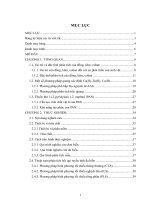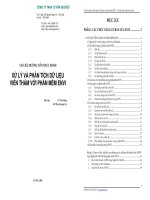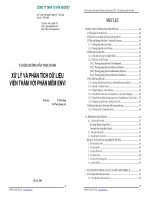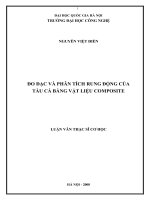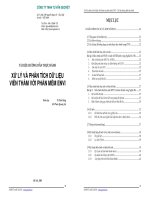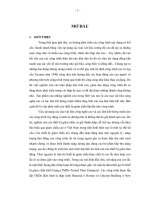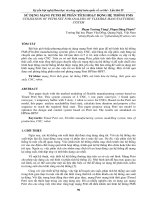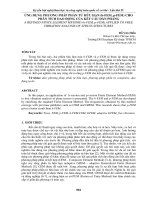Phan tich rung dong tham khao internet
Bạn đang xem bản rút gọn của tài liệu. Xem và tải ngay bản đầy đủ của tài liệu tại đây (4.34 MB, 110 trang )
Case study: Pump vibration at an electrical
utility
Tags: vibration analysis
A Reliable Plant reader, a maintenance planner at a major U.S. utility, recently submitted this case
study. It offers invaluable information to all of you who work on pumps.
During monthly vibration data collection rounds, a power station’s 500-horsepower vertical turbine
circulating water pump experienced a large increase in vibration compared to the previous month
readings.
The running speed vibration trend showed the November 2004 reading went from a normal 0.257
inches/second velocity to 0.468 inches/second in February 2005, and then increased again to 0.637
inches/second in March. Analyst review of the data found the largest response at the top of the motor,
which is normal for most vertical pumps as they tend to pivot at the pump discharge head mounting to
the floor. Resonance is common with this design of pump, however, the natural frequency of this
pump/motor system was found to be well above the 500 rpm operating speed of the pump through the
use of a simple bump test. The waveform pattern showing a predominant 1x (running speed) cycle
supported an imbalance/wear condition.
Knowing this, shaft displacement readings were taken in an effort to judge the severity of the problem.
After using a strobe light on the exposed pump shaft below the coupling to ensure no keyway or
protrusion would interfere, a shaft stick (fish tail) with the vibration sensor mounted on it was safely
held against the shaft. In the past, the shaft displacement had generally been around three to five
mils. Now the vibration exceeded 16 mils, all at running speed.
A spring outage was previously planned in three weeks for this unit. Due to the rapid change in
vibration and the severity, recommendations were made to pull the pump during this outage. The
pump was monitored on a bi-weekly basis until the outage to ensure it would not catastrophically fail.
Preparations were made for impeller replacement as this was likely the source of the high running
speed vibration due to imbalance, possibly from a broken vane due to foreign object damage or
excessive wear ring clearances. This type of damage was suspected because this pump is in a pit fed
by a nearby river and has a history of damage due to debris. River water is screened into the intake
house, however, during the spring, high river levels tend to bypass debris and repetitive failures of the
screen wash system have allowed debris past the screens which travels to the pit at the plant.
However, plant management still needed convincing that this was the problem, so prior to the outage,
divers were brought in to inspect the circulating water pit for debris and to look at the pump impeller.
The pit was surprisingly clean, but the diver found the pump impeller tips damaged and an obvious
offset to the fit of the impeller to the bowl. This likely meant that the impeller wear ring was worn
excessively and/or the lower shaft was bent.
Armed with this information, the pump was then scheduled for repair during the outage. Upon
inspection, the impeller wear ring was found worn, blade/vane tips were damaged/bent and the shaft
was bent. Parts were available for repair, but additional time was required to order a new shaft. The
condenser was found with excessive debris, so the hypothesis is that the pump had passed large
debris that likely bent the shaft. Repairs were completed within the timeframe of the scheduled outage
and the pump was successfully returned to service.
After the outage, an inspection of the remotely located river water intake house found damaged intake
screens and inefficient screen washing. In an effort to prevent any future failures to the circulating
water pumps, repairs were made to the screen and a new screen wash pump with a stand-by unit
were installed. A new control system was added to sense differential pressure on the screen
improving the overall efficiency of this system. Regular preventive maintenance inspections of the
intake house system were developed and scheduled in the computerized maintenance management
system to ensure this often neglected system is kept in good condition. To date, less debris has been
found in the condenser water boxes and the circulating water pumps have been running fine, but we
are still fighting the high water levels during the spring rains.
Acoustic Emission: The Next Generation of
Vibration Techniques
Martin Lucas, Kittiwake
Tags: vibration analysis, condition monitoring
History, experience and familiarity count for a lot where conditioning monitoring is
concerned, but that doesn’t negate the need for change, innovation and the advancement of
tried, tested and trusted techniques. The late Steve Jobs commented: “Innovation is the ability
to see change as an opportunity, not a threat.” Condition monitoring (CM) is transforming
rapidly and so too must the mindset of CM practitioners and users. It’s not good enough to
simply disregard a disruptive technology in an effort to protect the “old guard.” When
combating downtime, there’s no place for historical sentiment.
Steadily disrupting traditional vibration techniques is acoustic emission (AE). AE technology
spawned from the aviation industry where vibration analysis simply couldn’t be easily
applied, short of a suicidal maintenance technician hanging off the wings. AE technique is
based on frequencies much higher than are monitored in the repetitive, synchronous
movement of vibration. These frequencies are the result of shock, impact, friction and
cracking, for example. By this means, it is possible to detect impending failure before
damage occurs, as well as monitoring its progress thereafter.
With well-defined ISO standards, traditional vibration techniques including vibration
monitoring and vibration analysis have provided a trusted approach to condition monitoring
for the past 30 years. Yet, it remains a complex science and requires sophisticated knowledge
and understanding from a seasoned expert. In contrast, AE technology extends and simplifies
the science, placing the power of vibration techniques directly into the hands of every
engineer. Signals can be processed at the AE sensor into an easily understandable form.
Of course, vibration analysis (VA) as a technique will have a place for many for years to
come for many end users. However, there is no escaping the fact that there is often a
requirement for a costly and unsustainable level of knowledge required to affect a good
diagnosis. For VA, the defect repetition frequencies are critically dependent upon the machine
component design and geometry, as well as the precise running speed. Vibration can occur
independently in the X, Y or Z axis, and so orientation of the sensor is as important as
location. For a detailed interpretation, it is also necessary to know internal machine
geometries, shaft speeds, meshing frequencies, etc., and to analyze the data before making a
diagnosis. So in summary, VA is valuable but too often overly complicated.
With acoustic emission (AE), signal processing is undertaken automatically at the sensor
level.
With vibration analysis (VA), the signal is processed downstream manually or semiautomatically.
The areas in which vibration and AE both apply can be illustrated as overlapping circles.
However, AE provides an earlier warning, detecting wear and small defects, whereas with
vibration, damage must have occurred to detect a signal. AE will pick up a lack of
lubrication, friction and cracking, which vibration will not, although it must be acknowledged
that the totality of information obtained from AE will be more limited than that derived from
vibration.
The signal processing required by AE is not something that can be performed by just anyone;
it’s a high-frequency signal, so the user must have the knowledge to interpret the squiggly
lines on a stethoscope. However, recent developments have enabled this processing at the
sensor level. The sensor output can now provide pre-characterized numbers that tell you
about the condition of the machine. AE technology has been effectively de-skilled, enabling
much wider application use.
Suitable for continuously running machinery as well as machinery operating intermittently,
slowly or for short durations, AE allows the user to diagnose problems with machinery at an
early stage, carry out maintenance procedures and then monitor the improvement. It provides
real-time information with early sensitivity to faults and applicability to a wide range of
rotational speeds.
As awareness of the unique capabilities of AE increases, so too does the number of
applications that it is suited to, many of which have proven difficult for other forms of
condition monitoring to address. For example, the analysis of signals, whether from AE
sensors or accelerometers, requires a sufficiently long period of machine running at constant
speed so that a statistically meaningful signal characterization can be made. But that is where
the similarity stops. AE can be effective after around 10 seconds of measurements.
For example, the algorithm used to derive the widely used acoustic emission parameters of
Distress and dB Level in the MHC range of products from Kittiwake Holroyd requires a 10second period of running at an approximately constant speed. This compares favorably to
Fast Fourier Transform (FFT) based vibration analysis, which typically needs 60 to 120
seconds of measurement time and tight tolerances on machine speed for an effective signal
interpretation.
In cases where a hand-held instrument is used for periodic CM, it may be possible to interrupt
normal machine operation and put it into a special continuously running mode for the
duration of CM measurements. However, such disruption is not always possible and never
convenient. Furthermore, it is not compatible with the current trend toward CM automation,
which requires continuous online monitoring with permanently installed sensors inputting
CM data or status into supervisory control and data acquisition (SCADA) systems or
programmable logic controllers (PLCs).
So why are many CM practitioners being so resistant to the benefits that AE brings to the
table? It may be because many people have invested a lifetime in vibration and are
understandably wary of losing power and status. After all, if you “dumb down” vibration,
surely this reduces the perceived value that they bring to the organization. Actually, it doesn’t.
Just because AE is disruptive as a technology, it in no way invalidates traditional vibration
techniques but simply extends the impact way beyond what has been able to be achieved to
date.
For vibration techniques to be effective, you need equipment that’s far from cheap coupled
with clever people to get the best from it. Every result must be analyzed to understand what’s
good and what’s bad. For those who cannot afford the luxury of in-house vibration experts,
there are many vibration specialists who offer a contract monitoring service, which is not an
insignificant investment. While for some, the criticality of certain applications coupled with
the scale of some companies might justify this cost, others could still benefit from the
efficiencies realized by similar CM techniques.
Furthermore, the “we don’t buy into one-month wonders/we’ve all been bitten by the latest
whizz-bang technology” argument no longer rings true. Indeed, AE techniques are only
deemed disruptive because they are now mature with a proven track record.
Ultimately, maintenance personnel are responsible for keeping machinery running. If they are
empowered to monitor condition themselves, identify where action is needed and then check
that the action taken has solved the problem, then AE has significant advantages of cost,
speed, flexibility and ease of field application in comparison to traditional vibration analysis
techniques. It is the efficient and effective approach to CM.
To nurture the technology of a new era, a broader, longer-term view is required. Surely it
makes sense to embrace CM techniques that provide for the greatest protection or longest
period of warning for potential damage and eventual failure. By “de-skilling” technology, all
maintenance professionals are empowered to make informed decisions quickly and with
confidence, ultimately enabling them to positively and significantly impact a company’s
bottom line. Of course, there is room for sentiment in business but not at the expense of
progress.
Using Orbits for Condition Monitoring
Gary James, Ludeca, Inc.
Tags: condition monitoring, vibration analysis
Orbits have historically been used to measure relative shaft movement within a journal-type
bearing. The shape of the orbit told the analyst how the shaft was behaving within the bearing
as well as the probable cause of the movement. This was accomplished using proximity
probes usually mounted through the bearings with a 90-degree separation and a tip clearance
set to around 0.050 inches. With today’s modern analyzers, it is possible to also collect an
orbit using case-mounted velocity probes or accelerometers to see how the machine housing
is moving. Another way of putting it would be the orbit represents the absolute path in space
that the machine housing moves through (see Figure 1).
Figure 1
Figure 2
This is accomplished utilizing a two-channel instrument and collecting an orbit with the
sensor of choice being a velocity probe or accelerometer. This is what’s referred to as a poor
man’s operating deflection shape or ODS (see Figure 2).
The analyst can interpret the data to determine machine movement at a particular
measurement location or a section of the machine if a tachometer trigger is used during orbit
collection as a phase reference. Analysts must keep in mind the exact location of each sensor
so that when they look at the shape of the orbit it is possible to tell the movement in
relationship to the sensor’s location. The sensors should be placed 90 degrees apart or at least
as close as possible to 90 degrees. Keep in mind that a properly wired sensor shows motion
toward the sensor as a positive signal and motion away from the sensor as a negative signal.
An orbit is usually collected while the machine is at its normal operating state or speed, but it
can also be collected while the machine is increasing or decreasing in speed, such as during a
coast-down or startup. The data can be collected in a steady state, in what is known as an
unfiltered orbit, requiring no tachometer (see Figures 3 and 3A), or at multiples of running
speeds such as first, second or third order to look for issues relating to that or another specific
frequency (see Figures 4, 5, 6 and 7).
Figure 3 - Unfiltered displacement orbit
Figure 3A - Unfiltered velocity orbit
Figure 4 – Second order setup
Figure 6 – Third order setup
Figure 5 – Second order results
Figure 7 – Third order results
How to identify, correct a resonance
condition
Alain Pellegrino, Laurentide Controls Ltd.
Tags: vibration analysis, condition monitoring, predictive maintenance, maintenance and
reliability
Many experts working in the field of vibration analysis will agree that resonance is a very
common cause of excessive machine vibration.
Resonance is the result of an external force vibrating at the same frequency as the natural
frequency of a system. Natural frequency is a characteristic of every machine, structure and
even animals. Often, resonance can be confused with the natural frequency or critical
frequency. If equipment is operating in a state of resonance, the vibration levels will be
amplified significantly, which can cause equipment failure and plant downtime. It is,
therefore, important that the running speed of equipment be out of the resonance range.
How to identify a resonance frequency
Many techniques can be used to identify and/or confirm a high vibration level caused by a
resonance frequency. It is very important to confirm a resonance phenomenon by at least two
different types of tests before trying to correct it. We will look at a few techniques commonly
used in the industry.
Techniques used to confirm a resonance
Impact test:One of the most commonly used methods for measuring a system’s natural
frequency is to strike it with a mass and measure the response. This method is effective
because the impact inputs a small amount of force in the equipment over a large frequency
range. When performing this technique, it is important to try impacting different locations on
the structure since all of a structure’s resonant frequencies will always be measurable by
impacting at one location and measuring at the same location. Both drive point and transfer
point measurements should be taken when attempting to identify machine resonances.
This type of test must be performed with the equipment off. This way you can easily identify
the natural frequencies of the equipment (see Figure 1).
Figure 1. Impact Test, Equipment Off
Impact test using an instrumented hammer:This test is basically the same as a regular
impact test, except that an instrumented hammer is used to excite the system. This hammer,
equipped with an accelerometer at one end, is used in tandem with the sensor used to measure
the vibration. A two-channel vibration analyzer is needed, in which one channel is connected
to the instrumented hammer and the other to the vibration sensor.
Using this technique, you can effectively measure the force induced to the system by the
instrumented hammer and the response at different frequencies. When the phase shifts by 90
degrees, the frequency at which it occurs is a natural frequency (Figure 2). The advantage in
using this method is that it allows you to monitor phase shifts and coherence. With this
information, you can create operating deflection shapes to visualize the vibrating body.
Figure 2. Impact Test with Force Hammer
Coast down peak hold:Another method used is to monitor the vibration level using a peak
hold function, while shutting down the equipment, as performed normally. The vibration level
should drop at a steady rate. If the vibration levels start rising at any time while the
equipment is being shut down, the speed at which the amplitudes increase is a possible
natural frequency (Figure 3).
Figure 3. Coast Down Peak Hold
Coast down peak phase:Like the coast down peak hold, this test is to be conducted while
the equipment is being shut down. By installing a photo tack and a piece of reflective tape on
the rotating shaft of the equipment, you can monitor the vibration and its phase. This will
allow you to see the amplitude and phase shift at all running speeds of the equipment. If there
is no resonance excited by the turning speed, the vibration levels should drop at a steady rate.
If the vibration peaks at a certain speed and the phase shifts by 180 degrees, this indicates a
natural frequency of the equipment or structure. The actual natural frequency is the frequency
situated in the middle of the phase shift (90 degrees) (Figure 4).
Figure 4. Coast Down Peak Phase
Formula for natural frequency
The natural frequency is the frequency of free vibration of a system, in which a system
vibrates to dissipate its energy. The natural frequency (ωn) of an equipment, expressed in
radian per second, is a function of its stiffness (k) and its mass (m), as shown by the
following equation:
If any of these two parameters are altered, the natural frequency will change.
How do you modify a natural frequency?
If we want to modify the natural frequency of a body, we have to either change the stiffness
or the mass. Increasing the mass or lowering the stiffness will lower the natural frequency
while reducing mass or increasing stiffness will increase natural frequency.
How can we operate critical equipment if we can’t change the natural frequency?
If we cannot change the stiffness or the mass of the equipment, two possible choices are
offered to us. One easy solution is to change the operating speed of the equipment by 20 to 30
percent, but this is not usually an option. Another solution is to install a dynamic absorber on
the equipment to significantly reduce the vibration levels of the equipment. The dynamic
absorber is a spring-mass system that is installed in series with the resonant system to create
an out-of-phase exciting force to effectively counteract the initial exciting force.
Conclusion
Resonance is probably one of the five common causes of excessive machine vibration.
Identifying a resonance frequency effectively can be challenging. We need to positively
identify the natural frequency by performing at least two different tests such as impact test,
coast down peak hold, coast down peak phase or impact test using a force hammer.
Once the resonance is confirmed, either change the mass or the stiffness of the equipment to
change its natural frequency. If it cannot be accomplished try to change the operating speed
of the equipment. If that fails, consider installing a dynamic absorber to counteract the initial
exciting force.
Phase analysis: Making vibration analysis
easier
Tony DeMatteo, 4X Diagnostics, LLC
Tags: vibration analysis, condition monitoring, predictive maintenance
Vibration analysis is mostly a learned skill. It is based 70 percent on experience and 30
percent on classroom training and self study. It takes years to become a confident and
competent vibration analyst. When the analysis is wrong, the recommendations for repair also
will be incorrect. No vibration analyst wants to make the wrong call. In this business,
credibility is gained in small steps and lost in large chunks.
A vibration sensor placed on a bearing housing and connected to a vibration analyzer
provides time, frequency and amplitude information in the form of a waveform and a
spectrum (Figure 1). This data is the foundation for vibration analysis. It contains the
signatures of nearly all mechanical and electrical defects present on the machine.
Figure 1. Vibration Waveform and Spectrum
The vibration analysis process involves determining the vibration severity, identifying
frequencies and patterns, associating the peaks and patterns with mechanical or electrical
components, forming conclusions and, if necessary, making recommendations for repair.
Everybody involved in vibration analysis knows that analyzing vibration is not easy nor
automated. Have you ever wondered why? Here are a few reasons:
1) Machines Have Multiple Faults: The vibration patterns we learn in training and read
about in books just don’t look the same in the real world. We learn how mechanical and
electrical faults look in the purest form – as if there was always only that one problem on the
machine causing vibration. Machines usually have more than one vibration-producing fault.
At a minimum, all machines have some unbalance and misalignment. When other faults
develop, the waveform and spectrum quickly become complicated and difficult to analyze.
The data no longer matches the fault patterns we have learned.
2) Cause and Effect Vibration: For every action, there is a reaction. Some of the vibration
we measure is the effect of other problems. For example, the force caused by rotor unbalance
can make the machine look like it is out of alignment, loose or rubbing. Consider all of the
things that shake and rattle on your car when one tire goes out of balance.
3) Many Fault Types Have Similar Patterns: Because machine rotors rotate at a particular
speed, and vibration is a cyclical force, many mechanical and electrical faults exhibit similar
frequency patterns that make it difficult to distinguish one fault from another.
Learning to analyze vibration just takes time. Training courses, technical publications and
other resources such as online resources and commercial self teaching material are available
that can improve analysis skills and shorten the learning curve.
There is one diagnostic technique which quickly gets to the source of most vibration
problems. It is possibly the most powerful of all vibration diagnostic techniques. It has been
around as long as vibration analysis itself yet hasn’t gotten a lot of attention, and it’s rare to
find good information about the subject. What is this technique? It’s called phase analysis.
What is Phase?
Phase is the position of a rotating part at any instant with respect to a fixed point. Phase gives
us the vibration direction. Tuning a car engine using a timing light and inductive sensor is an
application of phase analysis (Figure 2).
Figure 2. Engine tuning using a timing light is phase analysis.
A phase study is a collection of phase measurements made on a machine or structure and
evaluated to reveal information about relative motion between components. In vibration
analysis, phase is measured using absolute or relative techniques.
Absolute phase is measured with one sensor and one tachometer referencing a mark on the
rotating shaft (Figure 3). At each measurement point, the analyzer calculates the time
between the tachometer trigger and the next positive waveform peak vibration. This time
interval is converted to degrees and displayed as the absolute phase (Figure 4). Phase can be
measured at shaft rotational frequency or any whole number multiple of shaft speed
(synchronous frequencies). Absolute phase is required for rotor balancing.
Figure 3. Absolute Phase Measurement
Figure 4. Absolute phase is calculated between the tach signal and vibration waveform.
Relative phase is measured on a multi-channel vibration analyzer using two or more (similar
type) vibration sensors. The analyzer must be able to measure cross-channel phase. One
single-axis sensor serves as the fixed reference and is placed somewhere on the machine
(typically on a bearing housing). Another single-axis or triaxial sensor is moved sequentially
to all of the other test points (Figure 5). At each test point, the analyzer compares waveforms
between the fixed and roving sensors. Relative phase is the time difference between the
waveforms at a specific frequency converted to degrees (Figure 6). Relative phase does not
require a tachometer so phase can be measured at any frequency.
Figure 5. Relative Phase Measurement
Figure 6. Relative Phase Calculated Between Two Vibration Waveforms
Both types of phase measurements are easy to make. Relative phase is the most convenient
way to measure phase on a machine because the machine does not need to be stopped to
install reflective tape on the shaft. Phase can be measured at any frequency. Most singlechannel vibration analyzers can measure absolute phase. Multi-channel vibration analyzers
like the Pruftechnik VibXpert illustrated in Figure 7 have standard functions for measuring
both absolute and relative phase.
Figure 7. Pruftechnik VibXpert 2-Channel Vibration Analyzer
When to use Phase Analysis
Everyone needs phase analysis. A phase study should be made on problem machines when
the source of the vibration is not clear or when it is necessary to confirm suspected sources of
vibration. A phase study might include points measured only on the machine bearings or it
can include points over the entire machine from the foundation up to the bearings. The
following are examples of how phase can help analyze vibration.
Soft Foot
The term soft foot is used to describe machine frame distortion. It can be caused by a
condition where the foot of a motor, pump or other component is not flat, square and tight to
its mounting, or many other things, such as machining errors, bent or twisted feet and non-flat
mounting surfaces. Soft foot increases vibration and puts undue stress on bearings, seals and
couplings. Soft foot on a motor distorts the stator housing creating a non-uniform rotor to
stator air gap resulting in vibration at two times line frequency.
A good laser shaft alignment system should be used to verify soft foot by loosening the
machine feet one at a time.
Phase can be used to identify soft foot while the machine is in operation. Measure vertical
phase between the foot and its mounting surface. If the joint is tight, the phase angle is the
same between surfaces. If the phase angle is different by more than 20 degrees, the foot is
loose or the machine frame is cracked or flimsy. Figure 8 is an example of the phase shift
across a soft foot.
Figure 8. A phase shift between the foot and mount may indicate soft foot.
Cocked Bearings and Bent Shafts
Phase is used to detect cocked bearings and bent shafts. Measure phase at four axial locations
around the bearing housing. If the bearing is cocked or the shaft is bent through the bearing,
the phase will be different at each location. If the shaft is straight and the bearing is not
twisting, the phase will be the same at each location (Figure 9).
Figure 9. Phase identifies in-plane or twisting bearing motion.
Confirm Imbalance
A once-per-revolution radial vibration usually means rotor unbalance. Use phase to prove
imbalance is the problem. To confirm imbalance, measure the horizontal and vertical phase
on a shaft or bearing housing. If the difference between the phase values is approximately 90
degrees, the problem is rotor unbalance (Figure 10). If the phase difference is closer to zero
or 180 degrees, the vibration is caused by a reaction force. An eccentric pulley and shaft
misalignment are examples of reaction forces.
Figure 10. Horizontal to Vertical Phase Shift of about 90 Degrees Confirms Unbalance
Looseness, Bending or Twisting
Phase is used to detect loose joints on structures and bending or twisting due to weakness or
resonance. To check for looseness, measure the vertical phase at each mechanical joint as
indicated by the arrows in Figure 11. When joints are loose, there will be a phase shift of
approximately 180 degrees. The phase angle will not change across a tight joint.
Figure 11. A phase shift between bolted joints indicates looseness.
Shaft Misalignment
Shaft misalignment is easily verified with phase. Measure each bearing in the horizontal,
vertical and axial directions. Record the values in a table or bubble diagram as shown in
Figure 12. Compare the horizontal phase from bearing to bearing on each component and
across the coupling. Repeat the comparison using vertical then axial data. Good alignment
will show no substantial phase shift between bearings or across the coupling. The machine in
Figure 12 has a 180-degree phase shift across the coupling in the radial directions. The axial
directions are in-phase across the machine. The data indicates parallel (offset) shaft
misalignment.
Figure 12. Phase Data Indicates Parallel Shaft Misalignment
Operational Deflection Shapes
Instead of comparing the phase and magnitude numbers from a table or bubble diagram,
operational deflection shape software (ODS) can be used to animate a machine drawing. An
ODS is a measurement technique used to analyze the motion of rotating equipment and
structures during normal operation. An ODS is an extension of phase analysis where a
computer-generated model of the machine is animated with phase and magnitude data or
simultaneously measured time waveforms. The animation is visually analyzed to diagnose
problems. ODS testing is able to identify a wide variety of mechanical faults and resonance
issues such as looseness, soft foot, broken welds, misalignment, unbalance, bending or
twisting from resonance, structural weakness and foundation problems.
Figure 13 is a simple ODS of three direct-coupled shafts. Phase and magnitude were
measured from permanently mounted X and Y displacement probes on a turbine generator.
The values listed in the table were used in ODS software to animate a stick figure drawing of
the high- and low-pressure turbine shafts and the generator shaft. The picture to the right of
the table is a capture from the ODS animation showing the vibration pattern of each shaft and
the relative motion between shafts at 3,600 cycles per minute (turning speed).
Figure 13. Shaft Operational Deflection Shape
Many machines vibrate due to deteriorated foundations, looseness, resonance of the support
structure and other problems that occur below the machine bearings. A phase study might
include hundreds of test points measured all over the machine and foundation. Good ODS
software can make it easier to analyze phase and magnitude data from a large number of test
points. Analysis of an ODS involves observation and interpretation of the machine in motion.
Figure 14 is an ODS structure drawing of a vertical pump.
Figure 14. Vertical Pump Operational Deflection Shape Structure Drawing
Conclusion
Condition-based vibration testing is a vital component of a reliability based maintenance
program. Vibration sensors, instruments and software are able to provide key information
about machine health. The weak link in the chain is the analyst’s ability to interpret the data,
accurately diagnose the problem and trend the fault until it is time to recommend corrective
action. Phase analysis is a very powerful diagnostic tool. Every vibration analyst should be
using phase to improve vibration analysis accuracy.
"Diagnostics of Rotating Machines in Power Plants"
Vibration Phase Analysis The first lesson
Posted on:Wednesday, June 19, 2013 comments:No Responses By: yabdo
category:Mechanical Engineering Views 221
Vibration Phase Analysis The first lesson
Phase Analysis The first lesson
Life for many vibration analysts revolves around the spectrum. If the fault is not obvious in the
spectrum then the fault may not be detected. And in some cases, the fault condition is
misdiagnosed because a number of conditions present themselves in very similar ways. The use
of phase readings can help you to differentiate between these conditions. If you master phase
analysis, your ability to diagnose faults correctly will be enhanced greatly.
Phase analysis is a very powerful tool. The perception may be that phase measurements are
difficult to collect or possibly that the readings are difficult to understand or interpret. Some may
even believe that phase measurements do not offer any useful information. They are wrong.
The aim of this article is to show that phase measurements are neither difficult to collect nor
difficult to understand.
We will start by revising the fundamentals of phase, and then look at how you can measure
phase with a single-channel data collector, a dual-channel data collector, and with a strobe.
In part two of this article, we will look at how these readings can be used to diagnose a wide
range of fault conditions: unbalance, misalignment, looseness, bent shaft, cocked bearing,
eccentricity and resonance. We will review how comparing phase readings can reveal so much
about the machine, and we will take a quick look at Operating Deflection Shape (ODS) and
modal analysis.
What is phase
Let’s first go through a review of phase.
Phase is all about timing
Phase is all about the relative timing of related events. Here are a few examples:
1. When balancing we are interested in the timing between the heavy spot on the rotor and
a reference point on the shaft. We need to determine where that heavy spot is located,
and the amount of weight required to counteract the rotational forces.
2. When we look at fault conditions such as unbalance, misalignment, eccentricity, and
foundation problems, we are interested in the dynamic forces inside the machine, and as
a result, the movement of one point in relation to another point.
3. We can use phase to understand the motion of the machine or structure when we
suspect a machine of structural resonance, where the whole machine may be swaying
from side to side, twisting this way and that, or bouncing up and down.
So, phase is very helpful when balancing, and when trying to understand the motion of a
machine or structure. But phase is also very useful when trying to diagnose machine fault
conditions. If your attitude is “the vibration levels are high – it needs to be overhauled”, then you
probably don’t care about phase. But if you want to make an accurate diagnosis, and correctly
distinguish between faults such as unbalance, misalignment and bent shaft, then phase is an
essential tool.
Phase fundamentals
If you measure the vibration from a machine and filter out all sources of vibration leaving only the
vibration at the frequency corresponding to the running speed (i.e. 1X vibration) then the time
waveform is a sine wave. The vibration level will be dictated by a number of factors, but let’s just
focus on the forces due to unbalance.
Let’s use a simple fan as our reference machine. There is a gold coin attached to one of the
blades which generates the unbalance force. We see a sine wave with the corresponding angles
of rotation as illustrated in Figure 1.
Figure 1: A sine wave with the corresponding angles of rotation
But this information by itself does not tell us very much. Phase is a relative measure, so we need
to compare one source of vibration to either another source of vibration or a reference of some
kind.
First we’ll try to understand phase by comparing two sources of vibration. If we had two identical
fans, each with coins on a blade (to generate an unbalance force), we would expect to see sine
waves from each fan as shown in Figure 2. If the fans were perfectly synchronized such that the
coins were both at the 12:00 position at the same time, they would be said to be “in-phase”.
Figure 2: The two fans are in-phase.
However, if one coin was at the top (12:00) when the other was at the bottom (6:00), they would
be “180° out-of-phase”, as shown in Figure 3. Why 180°? Because one rotation is 360°, so half
a rotation is 180°.
Figure 3: The two fans are 180° out-of-phase.
And if one coin was at the top, and the other was a quarter of a rotation around, they would be
90° (or 270°) out of phase, as shown in Figure 4.
Figure 4: The two fans are 90° out-of-phase.
Comparing two waveforms
If you look at the previous examples you can see two waveforms with the same frequency (the
fans are running at exactly the same speed). By comparing the two time waveforms we can see
the time difference between them. In our example the waveforms have come from two different
fans. We are normally interested in two sources of vibration from the same machine.
We can determine the phase difference by first measuring the period (i.e. time) of one complete
cycle (remember, one cycle is 360°) and comparing that to the difference in time between the
waves, as illustrated in Figure 5.
Figure 5: Two waveforms, highlighting the time delay between them
Using a reference
Instead of measuring phase as a time difference between two sources of vibration, it can be
measured as a time difference between a source of vibration and a “reference”.
The two most common references are to place a piece of reflective tape on the shaft and then
use a photo cell or laser to generate a pulse each time the shaft rotates, or to use a displacement
probe opposite a keyway. Each time the keyway passes the tip of the displacement transducer,
the measured displacement changes dramatically so the signal will have a step change. We
discuss these measurement setups in greater detail later in this article.
The result is a voltage signal that provides a “TTL” pulse once-per-revolution as shown in Figure
6. The time between pulses is the period of the machine speed. To keep the numbers simple,
let’s assume the fan was rotating at 1500 RPM, or 25 Hz. Therefore the time between the pulses
would be 0.04 seconds (1/25 = 0.04).
Figure 6: Tachometer signal from a fan
As before, we can compare the vibration from the machine to the reference signal as illustrated
in Figure 7. The time between pulses is 0.04 seconds, and the time between the peaks of the
wave would be 0.04 seconds. If there is 0.01 seconds between the pulse and the peak of the
wave, then the phase difference would be 90°. Note: ¼ of 0.04 seconds is 0.01 seconds. ¼ of
360° is 90°.
Figure 7: Sine wave and tachometer signal showing the time and phase difference
Fortunately the data collector has the electronics and software necessary to utilize tachometer
signals or signals from accelerometers in order to determine the phase angle, so these
calculations are performed automatically.
Collecting phase readings
Let’s take a closer look at how we measure phase. In the previous section we described two
basic methods: using a tachometer reference, and using the vibration from another sensor.
There is a third method that utilizes a strobe, but we’ll get to that later.
Using a tachometer
There are a number of ways to obtain a once-per-revolution tachometer signal. The most
common involves the use of reflective tape and an optical (or laser) tachometer as illustrated in
Figure 8.
Figure 8: Accelerometer and laser-tachometer installed on a fan
There are a number of products available that can use reflected light, including laser light, to
generate the tachometer signal. Some will work without reflective tape, as long as there is an
area of high contrast – for example, a paint spot.
The photocell shines a light (visible or laser) on to the shaft. Due to the surface texture and
color, the light does not normally reflect. When the tape passes underneath, the light reflects.
The tachometer generates a “TTL” signal that is fed into the data collector.
Another way to generate a once-per-revolution signal is to use a displacement (proximity) probe
which is aimed at a keyway or setscrew. The change in displacement provides the step in
voltage which is used as the reference. This is commercially known as a “keyphasor” (by Bently
Nevada).
The output from the tachometer is fed into the tachometer input of the data collector; it may be
labelled “EXT” or “TACH” or “TRIG” or by some other label. You will need to refer to the
operating manual of your data collector to understand where to connect the tachometer signal
and how to use it to collect phase readings. Figure 9 is an example of one such data collector,
used by DI, SKF, DLI and Rockwell (Entek).
Figure 9: Trigger (tachometer) input of a typical data collector
The data collector is then able to use the tachometer signal to determine the speed of the
machine, and as a reference to compare the vibration at the running speed (1X) from an
accelerometer, as illustrated in Figure 10. It will then provide a phase angle of between 0° and
360° (in some cases the data collector may provide a reading of -180° to +180°).
